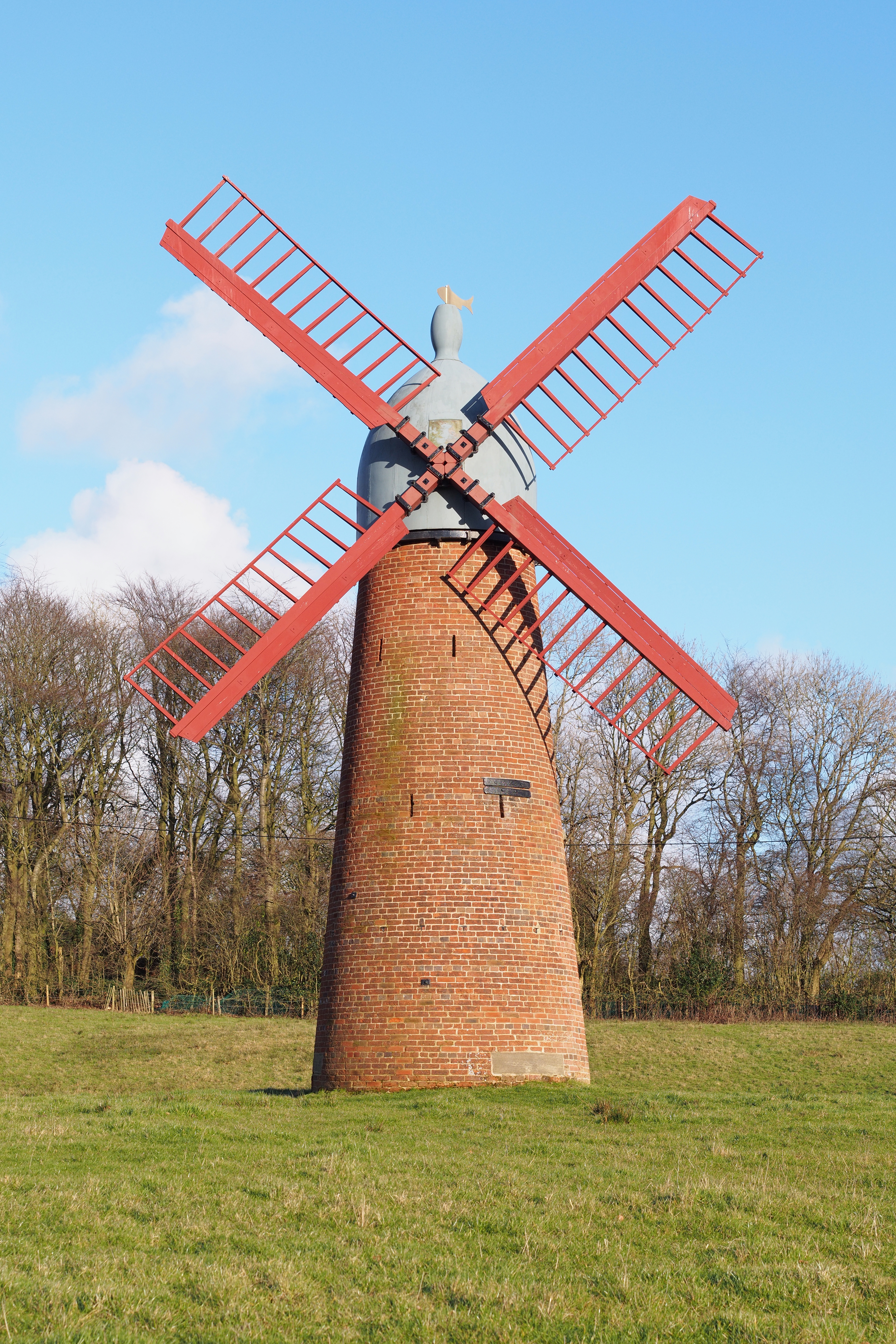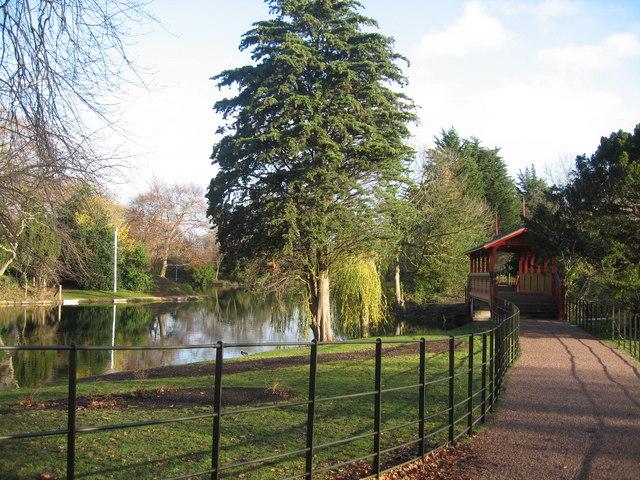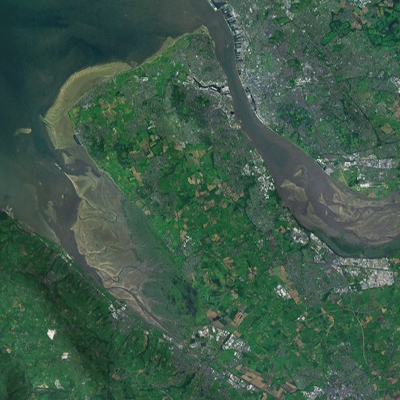|
Bidston Windmill
Bidston Windmill is situated on Bidston Hill, near Birkenhead, on the Wirral Peninsula, England. History It is believed that there has been a windmill, on this site, since 1596. The mill was ideally placed to catch the wind and was able to produce over of flour every 3 to 5 minutes. However, the mill was difficult to access by cart. The previous structure, a wooden peg mill, was destroyed by fire in 1791 (although some sources state 1793). During a gale, the sails got out of control and the friction produced by the revolving wooden mechanism caused the entire mill to burst into flames. The current building was built around 1800 and continued working as a flour Flour is a powder made by grinding raw grains, roots, beans, nuts, or seeds. Flours are used to make many different foods. Cereal flour, particularly wheat flour, is the main ingredient of bread, which is a staple food for many culture ... mill until about 1875. After falling into disuse the windmil ... [...More Info...] [...Related Items...] OR: [Wikipedia] [Google] [Baidu] |
Grist Mill
A gristmill (also: grist mill, corn mill, flour mill, feed mill or feedmill) grinds cereal grain into flour and Wheat middlings, middlings. The term can refer to either the Mill (grinding), grinding mechanism or the building that holds it. Grist is grain that has been separated from its chaff in preparation for grinding. History Early history The Greek geographer Strabo reports in his ''Geography'' a water-powered grain-mill to have existed near the palace of king Mithradates VI Eupator at Cabira, Asia Minor, before 71 BC. The early mills had horizontal paddle wheels, an arrangement which later became known as the "Water wheel#Vertical axis, Norse wheel", as many were found in Scandinavia. The paddle wheel was attached to a shaft which was, in turn, attached to the centre of the millstone called the "runner stone". The turning force produced by the water on the paddles was transferred directly to the runner stone, causing it to grind against a stationary "Mill machinery#Wat ... [...More Info...] [...Related Items...] OR: [Wikipedia] [Google] [Baidu] |
Tower Mill
A tower mill is a type of vertical windmill consisting of a brick or stone tower, on which sits a wooden 'cap' or roof, which can rotate to bring the sails into the wind.Medieval science, technology, and medicine: an encyclopedia (2005), 520 This rotating cap on a firm masonry base gave tower mills great advantages over earlier post mills, as they could stand much higher, bear larger sails, and thus afford greater reach into the wind. Windmills in general had been known to civilization for centuries, but the tower mill represented an improvement on traditional western-style windmills. The tower mill was an important source of power for Europe for nearly 600 years from 1300 to 1900, contributing to 25 percent of the industrial power of all wind machines before the advent of the steam engine and coal power. It represented a modification or a demonstration of improving and adapting technology that had been known by humans for ages. Although these types of mills were effectiv ... [...More Info...] [...Related Items...] OR: [Wikipedia] [Google] [Baidu] |
Bidston Hill
Bidston Hill is of heathland and woodland containing historic buildings and ancient rock carvings, on the Wirral Peninsula, near the Birkenhead suburb of Bidston, in Merseyside, England. With a peak of , Bidston Hill is one of the highest points on the Wirral. The land was part of Sir Robert Vyner's estate and purchased by Birkenhead Corporation in 1894 for use by the public. Etymology Bidston Hill bears the name of the village of Bidston, the name being recorded in 1260 as ''Bedistan''; origin possibilities include variations of the Old English name ' Beda' or 'Byddi' combined with ''ton'', or from 'bytle stan', meaning a dwelling on a rock, or possibly a reference to a 'bidding-stone' for a venerated Saxon. Geography Bidston Hill is in the north-east of the Wirral Peninsula and reaches at its highest point. Geology The exposed ridgeline along Bidston Hill is composed of brown, buff and grey Delamere Pebbly Sandstone of fluvial origin, part of the Helsby Sandstone ... [...More Info...] [...Related Items...] OR: [Wikipedia] [Google] [Baidu] |
Birkenhead
Birkenhead (; cy, Penbedw) is a town in the Metropolitan Borough of Wirral, Merseyside, England; historically, it was part of Cheshire until 1974. The town is on the Wirral Peninsula, along the south bank of the River Mersey, opposite Liverpool. At the 2011 census, it had a population of 88,818. Birkenhead Priory and the Mersey Ferry were established in the 12th century. In the 19th century, Birkenhead expanded greatly as a consequence of the Industrial Revolution. Birkenhead Park and Hamilton Square were laid out as well as the first street tramway in Britain. The Mersey Railway connected Birkenhead and Liverpool with the world's first tunnel beneath a tidal estuary; the shipbuilding firm Cammell Laird and a seaport were established. In the second half of the 20th century, the town suffered a significant period of decline, with containerisation causing a reduction in port activity. The Wirral Waters development is planned to regenerate much of the dockland. Toponymy The ... [...More Info...] [...Related Items...] OR: [Wikipedia] [Google] [Baidu] |
Wirral Peninsula
Wirral (; ), known locally as The Wirral, is a peninsula in North West England. The roughly rectangular peninsula is about long and wide and is bounded by the River Dee to the west (forming the boundary with Wales), the River Mersey to the east, and the Irish Sea to the north. Historically, the Wirral was wholly in Cheshire; in the Domesday Book, its border with the rest of the county was placed at "two arrow falls from Chester city walls". However, since the Local Government Act 1972, only the southern third has been in Cheshire, with almost all the rest lying in the Metropolitan Borough of Wirral, Merseyside. An area of saltmarsh to the south-west of the peninsula lies in the Welsh county of Flintshire. The most extensive urban development is on the eastern side of the peninsula. The Wirral contains both affluent and deprived areas, with affluent areas largely in the west, south and north of the peninsula, and deprived areas concentrated in the east, especially Bir ... [...More Info...] [...Related Items...] OR: [Wikipedia] [Google] [Baidu] |
Windmill
A windmill is a structure that converts wind power into rotational energy using vanes called windmill sail, sails or blades, specifically to mill (grinding), mill grain (gristmills), but the term is also extended to windpumps, wind turbines, and other applications, in some parts of the English speaking world. The term wind engine is sometimes used to describe such devices. Windmills were used throughout the High Middle Ages, high medieval and early modern periods; the horizontal or panemone windmill first appeared in Persia during the 9th century, and the vertical windmill first appeared in northwestern Europe in the 12th century. Regarded as an icon of Culture of the Netherlands, Dutch culture, there are approximately 1,000 windmills in the Netherlands today. Forerunners Wind-powered machines may have been known earlier, but there is no clear evidence of windmills before the 9th century. Hero of Alexandria (Heron) in first-century Roman Egypt described what appears to be a ... [...More Info...] [...Related Items...] OR: [Wikipedia] [Google] [Baidu] |
Post Mill
The post mill is the earliest type of European windmill. Its defining feature is that the whole body of the mill that houses the machinery is mounted on a single vertical post, around which it can be turned to bring the sails into the wind. All post mills have an arm projecting from them on the side opposite the sails and reaching down to near ground level. With some, as at Saxtead Green, the arm carries a fantail to turn the mill automatically. With the others the arm serves to rotate the mill into the wind by hand. The earliest post mills in England are thought to have been built in the 12th century. The earliest working post mill in England still used today is to be found at Outwood, Surrey. It was built in 1665. The earliest remaining example of a non-operational mill can be found in Great Gransden in Cambridgeshire, built in 1612.Windmills in Huntingdon and Peterborough. p. 3. Their design and usage peaked in the 18th and 19th centuries and then declined after the introdu ... [...More Info...] [...Related Items...] OR: [Wikipedia] [Google] [Baidu] |
Flour
Flour is a powder made by grinding raw grains, roots, beans, nuts, or seeds. Flours are used to make many different foods. Cereal flour, particularly wheat flour, is the main ingredient of bread, which is a staple food for many cultures. Corn flour has been important in Mesoamerican cuisine since ancient times and remains a staple in the Americas. Rye flour is a constituent of bread in central and northern Europe. Cereal flour consists either of the endosperm, germ, and bran together (whole-grain flour) or of the endosperm alone (refined flour). ''Meal'' is either differentiable from flour as having slightly coarser particle size (degree of comminution) or is synonymous with flour; the word is used both ways. For example, the word '' cornmeal'' often connotes a grittier texture whereas corn flour connotes fine powder, although there is no codified dividing line. The CDC has cautioned not to eat raw flour doughs or batters. Raw flour can contain bacteria like '' E. col ... [...More Info...] [...Related Items...] OR: [Wikipedia] [Google] [Baidu] |
Oxton, Merseyside
Oxton is a suburb of Birkenhead, Merseyside, England. Administratively it is a ward of the Metropolitan Borough of Wirral. Originally a village in its own right, it became part of the Municipal Borough of Birkenhead upon its creation in 1877. Before local government reorganisation on 1 April 1974, it was part of the County Borough of Birkenhead, within the county of Cheshire. History The name ''Oxa-tún'' derives from Old Norse, meaning "a farm or enclosure where oxen are kept". By 1278, the name had been adapted into Old English as ''Oxeton'' and was recorded as ''Oxon'' in 1549. Oxton was once one of the most affluent areas in England mainly due to its proximity to Liverpool and the fact that along with various other Wirral locations, it was a favourite residential area for wealthy Liverpool merchants and tradesmen of the time. Oxton Village is a mainly early Victorian era settlement with fine sandstone and brick built houses, many of which now form part of a conservation are ... [...More Info...] [...Related Items...] OR: [Wikipedia] [Google] [Baidu] |
Anno Domini
The terms (AD) and before Christ (BC) are used to label or number years in the Julian and Gregorian calendars. The term is Medieval Latin and means 'in the year of the Lord', but is often presented using "our Lord" instead of "the Lord", taken from the full original phrase "''anno Domini nostri Jesu Christi''", which translates to 'in the year of our Lord Jesus Christ'. The form "BC" is specific to English and equivalent abbreviations are used in other languages: the Latin form is but is rarely seen. This calendar era is based on the traditionally reckoned year of the conception or birth of Jesus, ''AD'' counting years from the start of this epoch and ''BC'' denoting years before the start of the era. There is no year zero in this scheme; thus ''the year AD 1 immediately follows the year 1 BC''. This dating system was devised in 525 by Dionysius Exiguus, but was not widely used until the 9th century. Traditionally, English follows Latin usage by placing the "AD" abbr ... [...More Info...] [...Related Items...] OR: [Wikipedia] [Google] [Baidu] |
Buildings And Structures In The Metropolitan Borough Of Wirral
A building, or edifice, is an enclosed structure with a roof and walls standing more or less permanently in one place, such as a house or factory (although there's also portable buildings). Buildings come in a variety of sizes, shapes, and functions, and have been adapted throughout history for a wide number of factors, from building materials available, to weather conditions, land prices, ground conditions, specific uses, prestige, and aesthetic reasons. To better understand the term ''building'' compare the list of nonbuilding structures. Buildings serve several societal needs – primarily as shelter from weather, security, living space, privacy, to store belongings, and to comfortably live and work. A building as a shelter represents a physical division of the human habitat (a place of comfort and safety) and the ''outside'' (a place that at times may be harsh and harmful). Ever since the first cave paintings, buildings have also become objects or canvasses of much art ... [...More Info...] [...Related Items...] OR: [Wikipedia] [Google] [Baidu] |
Windmills In Merseyside
A windmill is a structure that converts wind power into rotational energy using vanes called sails or blades, specifically to mill grain ( gristmills), but the term is also extended to windpumps, wind turbines, and other applications, in some parts of the English speaking world. The term wind engine is sometimes used to describe such devices. Windmills were used throughout the high medieval and early modern periods; the horizontal or panemone windmill first appeared in Persia during the 9th century, and the vertical windmill first appeared in northwestern Europe in the 12th century. Regarded as an icon of Dutch culture, there are approximately 1,000 windmills in the Netherlands today. Forerunners Wind-powered machines may have been known earlier, but there is no clear evidence of windmills before the 9th century. Hero of Alexandria (Heron) in first-century Roman Egypt described what appears to be a wind-driven wheel to power a machine.Dietrich Lohrmann, "Von de ... [...More Info...] [...Related Items...] OR: [Wikipedia] [Google] [Baidu] |










